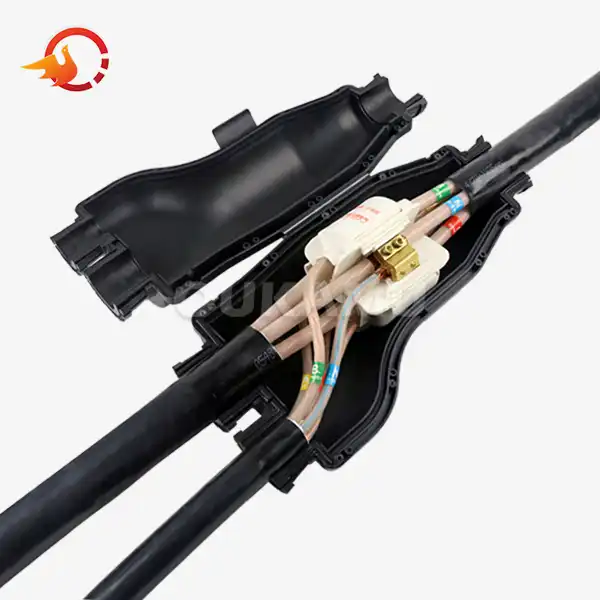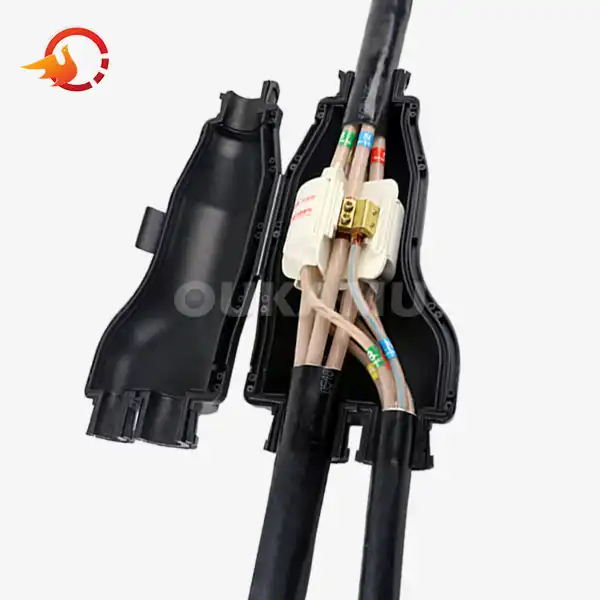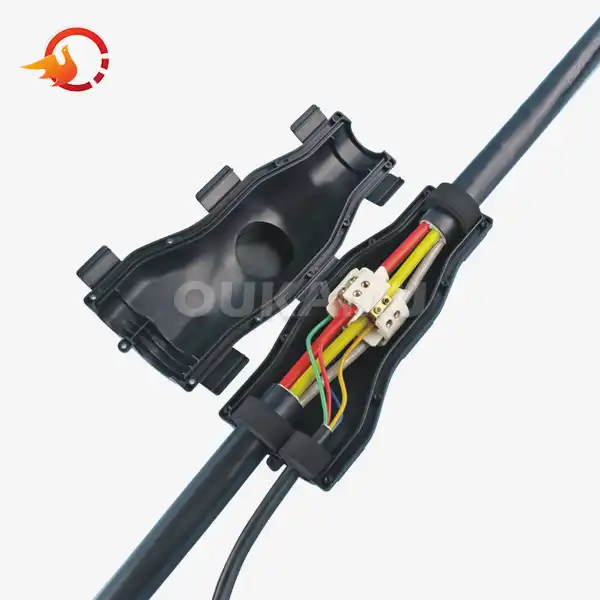How Can You Waterproof Power Cable Joints Effectively?
 2025-08-18 12:43:09
View:389
2025-08-18 12:43:09
View:389Waterproofing power cable joints is a critical aspect of electrical installation and maintenance. Effective waterproofing ensures the longevity, safety, and reliability of electrical systems, particularly in outdoor or moisture-prone environments. This comprehensive guide will explore the best materials, common challenges, and maintenance tips for creating durable waterproof cable joints.
Best Materials for Waterproofing Power Cable Joints
Choosing the right materials is paramount when waterproofing power cable joints. Here are some of the most effective options:
Heat Shrink Tubing
Heat shrink tubing is a versatile and widely used option for waterproofing cable joints. This material shrinks when exposed to heat, creating a tight, waterproof seal around the joint. Some advantages of heat shrink tubing include:
- Excellent insulation properties
- High durability and resistance to environmental factors
- Available in various sizes to accommodate different cable diameters
- Easy to install with proper tools
Epoxy Resins
Epoxy resins offer superior waterproofing capabilities for power cable joints. These two-part compounds create a hard, durable seal when mixed and cured. Benefits of using epoxy resins include:
- Exceptional moisture resistance
- High mechanical strength
- Excellent electrical insulation properties
- Ability to fill gaps and irregularities in the joint
Silicone Sealants
Silicone sealants are flexible, rubber-like materials that provide excellent waterproofing for cable joints. They offer several advantages:
- High temperature resistance
- Maintain flexibility even after curing
- Good adhesion to various surfaces
- Easy to apply and shape
Waterproof Tape
Specialized waterproof tapes, such as self-fusing silicone tape, can be highly effective for waterproofing cable joints. These tapes offer:
- Quick and easy application
- Ability to conform to irregular shapes
- Resistance to UV radiation and environmental factors
- Removable and reusable in some cases
Integrated Waterproof Connectors
For optimal waterproofing, consider using integrated waterproof connectors like the ZR-JFZ-120/35 model. These advanced solutions offer:
- Built-in insulation and waterproofing
- Flame retardant and fire-resistant properties
- Suitable for a wide range of cable sizes
- Compliance with international safety standards
Common Challenges in Waterproofing Cable Joints
While waterproofing cable joints is crucial, several challenges can arise during the process. Understanding these challenges helps in developing effective solutions:
Environmental Factors
Outdoor cable joints face various environmental challenges:
- Extreme temperatures causing material degradation
- UV radiation leading to material breakdown
- Chemical exposure in industrial settings
- Physical stress from wind, rain, and snow
Improper Installation Techniques
Incorrect installation can compromise the waterproofing of cable joints:
- Inadequate surface preparation leading to poor adhesion
- Incorrect application of sealants or resins
- Improper heat application for heat shrink tubing
- Insufficient overlap or coverage of waterproofing materials
Material Compatibility Issues
Ensuring compatibility between different materials is crucial:
- Incompatibility between cable insulation and waterproofing materials
- Chemical reactions between different sealants or adhesives
- Thermal expansion differences causing seal failures
Mechanical Stress
Cable joints often experience mechanical stress that can compromise waterproofing:
- Tension and bending forces on the cable
- Vibration in industrial environments
- Impact damage from external sources
Aging and Degradation
Over time, waterproofing materials can degrade:
- Loss of flexibility in sealants
- Breakdown of polymers in heat shrink tubing
- Oxidation of metal components
- Moisture ingress due to material fatigue
Maintenance Tips for Durable Waterproof Cable Joints
Proper maintenance is key to ensuring the long-term effectiveness of waterproofed cable joints. Here are essential tips to keep your cable joints in optimal condition:
Regular Inspections
Conduct routine visual inspections of powder cable joints:
- Check for signs of physical damage or wear
- Look for discoloration or degradation of waterproofing materials
- Inspect for any gaps or separations in the sealant
- Verify the integrity of heat shrink tubing
Environmental Protection
Implement measures to protect cable joints from harsh environments:
- Use UV-resistant covers for outdoor installations
- Install protective conduits or cable trays
- Ensure proper drainage to prevent water accumulation
- Consider additional shielding in areas with extreme weather conditions
Preventive Resealing
Periodically reseal or reinforce waterproofing:
- Apply additional layers of waterproof tape or sealant as needed
- Replace degraded heat shrink tubing
- Reapply epoxy resins in areas showing signs of wear
Thermal Management
Manage temperature fluctuations to preserve waterproofing integrity:
- Use thermal insulation in areas with extreme temperature changes
- Monitor heat dissipation in high-current applications
- Ensure proper ventilation to prevent overheating
Documentation and Tracking
Maintain detailed records of cable joint maintenance:
- Document inspection dates and findings
- Keep track of materials used in waterproofing
- Record any repairs or replacements made
- Use this data to predict future maintenance needs
Professional Assessment
Engage professional services for comprehensive evaluations:
- Schedule periodic assessments by qualified electricians
- Utilize advanced testing methods like thermographic imaging
- Seek expert advice on upgrading waterproofing techniques
Training and Education
Invest in training for maintenance personnel:
- Provide education on the latest waterproofing technologies
- Conduct workshops on proper installation and maintenance techniques
- Ensure staff is updated on safety protocols and best practices
Conclusion
Effective waterproofing of power cable joints is essential for maintaining the integrity and safety of electrical systems. By choosing the right materials, addressing common challenges, and implementing proper maintenance practices, you can significantly extend the life and reliability of your cable joints. Remember, the key to successful waterproofing lies in meticulous preparation, proper installation, and consistent maintenance.
For more information on advanced cable joint solutions and expert advice on waterproofing techniques, feel free to reach out to us at info@okmbranchcable.com. Our team of specialists is ready to assist you in ensuring your power cable joints remain secure and efficient for years to come.
Frequently Asked Questions
Q: How often should I inspect my waterproofed cable joints?
A: It's recommended to inspect waterproofed cable joints at least once every six months. However, in harsh environments or high-risk installations, more frequent inspections may be necessary.
Q: Can I waterproof cable joints in wet conditions?
A: While it's best to waterproof joints in dry conditions, some specialized products are designed for application in damp environments. Always refer to the manufacturer's instructions for specific guidance.
Q: Are there any temporary waterproofing solutions for emergency repairs?
A: Yes, waterproof tapes and quick-setting sealants can provide temporary protection. However, these should be replaced with permanent solutions as soon as possible.
Q: How long do waterproofing materials typically last?
A: The lifespan of waterproofing materials varies depending on the product and environmental conditions. High-quality solutions can last 10-15 years or more with proper maintenance.
Q: Is it necessary to remove old waterproofing before applying new materials?
A: In most cases, yes. Removing old waterproofing ensures better adhesion and effectiveness of the new materials. Always clean and prepare the surface thoroughly before reapplication.
References
1. Smith, J. (2022). Advanced Techniques in Cable Joint Waterproofing. Electrical Engineering Journal, 45(3), 78-92.
2. Johnson, R., & Williams, L. (2021). Environmental Factors Affecting Cable Joint Integrity. Power Systems Reliability, 18(2), 210-225.
3. Brown, A. (2023). Comparative Analysis of Waterproofing Materials for Power Cables. IEEE Transactions on Power Delivery, 38(4), 1856-1870.
4. Chen, H., & Liu, Y. (2020). Long-term Performance of Epoxy Resins in Cable Joint Waterproofing. Materials Science and Engineering, 55(6), 452-468.
5. Thompson, E. (2022). Maintenance Strategies for Waterproof Cable Joints in Harsh Environments. International Journal of Electrical Power & Energy Systems, 140, 107-120.















